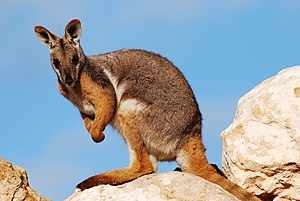Yellow-footed rock kangaroo
| Yellow-footed rock kangaroo | ||||||||||||
|---|---|---|---|---|---|---|---|---|---|---|---|---|

Yellow-footed rock kangaroo ( Petrogale xanthopus ) |
||||||||||||
| Systematics | ||||||||||||
|
||||||||||||
| Scientific name | ||||||||||||
| Petrogale xanthopus | ||||||||||||
| Gray , 1855 |
The yellow-footed rock kangaroo ( Petrogale xanthopus ) is a species of marsupial from the kangaroo family (Macropodidae). It is considered one of the most colorful kangaroos and is native to southern and eastern Australia .
features
Yellow-footed kangaroos have the typical physique of the kangaroos with the short front legs, the strong hind legs and the long tail. They reach a head body length of 48 to 65 centimeters, the tail is 57 to 70 centimeters long. The weight varies between 6 and 11 kilograms, with males becoming heavier than females. Their fur is gray on the back and white on the belly, the back of the ears and the front and rear legs are reddish-yellow. They have white stripes on their cheeks and thighs. The tail is curled brown and yellow.
distribution and habitat
Yellow-footed rock kangaroos have a very fragmented range, they are found in southwest Queensland , eastern South Australia and western New South Wales . Their habitat are rocky hill and mountain regions in a rather dry environment. Their habitats are often made up of acacias .
Way of life
These kangaroos are nocturnal and spend the day hidden in crevices or caves. You can climb well in the rocky terrain and jump distances of 4 meters. They live in loose groups that usually contain fewer than 20 animals.
Like all kangaroos, they are herbivores. In the rainy season they mainly eat grass, in the dry season leaves play a more important role in their diet.
Reproduction
Mating can take place all year round, before that the males fight among themselves for the mating privilege. After a gestation period of around 30 to 32 days, a single young is usually born. This spends around six to seven months in the mother's pouch. It becomes sexually mature at around 18 to 20 months. As with many other kangaroos, there is a "delayed birth": Immediately after the birth of a young animal, the female mates again. However, this embryo hardly continues to grow until the large young animal has finally left the pouch. Only then does it develop further and is born.
Danger
Yellow-footed rock kangaroos were mainly hunted for their fur between 1880 and 1920; today they are under protection in Australia. The greatest threat today comes from competition from domestic sheep and domestic goats , and there are also reenactments from introduced red foxes . The strict control of foxes and domestic goats has meanwhile led to local populations in some areas, such as the Flinders Range . In contrast to the red fox, the dingo , which has been found in Australia for thousands of years, seems to have a positive influence on the population of the yellow-footed rock kangaroo. He also chases the animals, but at the same time keeps the populations of foxes and cats short. It also feeds itself to a large extent on much larger species. It is unclear whether the survival of threatened smaller mammals such as the yellow-footed rock kangaroo even depends on the occurrence of the dingo. So far, this notion has been challenged by the presence of populations of the yellow-footed rock kangaroo south of the dingo fence . The dingo fence is a line designed to keep the fertile southeast of Australia dingo-free. A recent study, however, came to the conclusion that dingoes live in the near range of all examined yellow-footed kangaroo populations, including south of the dingo fence.
The IUCN assumes a total of fewer than 10,000 yellow-footed rock kangaroos. About 6000 of them live in South Australia, only a few hundred live in New South Wales in the area of the Mutawintji National Park . The Queensland populations are unknown. However, the stocks of the species fluctuate strongly depending on the amount of rain. The IUCN lists the yellow-footed rock kangaroo as a type of "warning list" ( near threatened ).
In Germany, the yellow-footed rock kangaroo is only found in Berlin Zoo and Dortmund Zoo.
literature
- Ronald Nowak: Walker's Mammals of the World. Johns Hopkins University Press, Baltimore 1999, ISBN 0-8018-5789-9 .
Individual evidence
- ^ Arian D. Wallach Brad R. Murray, Adam J. O'Neill: Can threatened species survive where the top predator is absent? In: Biological Conservation. Volume 142, 2009, pp. 43-52.
- ^ Zootierliste.de , accessed on September 5, 2015.


